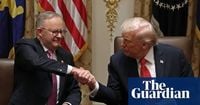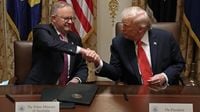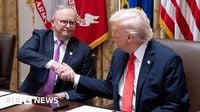In a move set to reshape the global landscape of critical minerals, U.S. President Donald Trump and Australian Prime Minister Anthony Albanese signed a landmark agreement at the White House on October 20, 2025, aiming to counter China’s longstanding dominance in the rare earths market. The $8.5 billion deal, described by both leaders as a leap forward in their countries’ partnership, is designed to boost supplies of rare earth elements and other vital minerals essential for modern technology, from electric vehicles to fighter jets and semiconductors.
The agreement comes at a pivotal moment. According to the Associated Press, China currently controls about 70% of rare earth mining and an even more staggering 90% of global processing. This stranglehold has prompted growing concern in Washington and Canberra, especially after Beijing recently announced new export controls requiring government approval for magnets containing even trace amounts of rare-earth materials originating from, or produced with, Chinese technology. The Trump administration has argued that such measures give China outsized leverage over global supply chains, with Kevin Hassett, director of the White House’s National Economic Council, stating, “Australia is really, really going to be helpful in the effort to take the global economy and make it less risky, less exposed to the kind of rare earth extortion that we’re seeing from the Chinese.”
Prime Minister Albanese, visiting Washington with a delegation of ministers overseeing resources, industry, and science, emphasized the scale of the Australian pipeline: “We have an $8.5 billion pipeline that we have ready to go.” The deal will see both countries each contribute $1 billion over the next six months to fund immediately available projects, with a White House fact sheet later clarifying the total joint investment will exceed $3 billion in that period (BBC). The projects are expected to expand Australia’s mining and processing capabilities, while also supporting the construction of a 100 tonnes-per-year advanced gallium refinery in Western Australia. The U.S. is preparing to offer some $2.2 billion in financing through its Export-Import Bank, which could unlock up to $5 billion in total investment, according to Reuters.
The market’s reaction was swift. Shares of Australian rare earth mining companies surged after the announcement. Perth-based Arafura Rare Earths jumped about 7.7%, Iluka Resources gained over 3%, and smaller miners like VHM and Latrobe Magnesium soared by 20% and 15.4% respectively. Even NYSE-listed Alcoa, which is developing a gallium recovery and refining project in Western Australia, was named a priority project under the new deal, sending its shares up 7.5% (CNBC).
Yet, the path to reducing China’s dominance is not without its hurdles. As Pini Althaus, CEO of Cove Capital and a veteran in the mining industry, told AP, “I think taking away that arrow in the quiver of China to manipulate pricing is an absolute crucial first step in Australia and the West being able to develop critical minerals projects to meet our supply chain demands.” For decades, China has been accused of dumping excess critical minerals onto the market to drive prices so low that competitors elsewhere are forced out of business. To counter this, the U.S. and Australia agreed to cooperate on pricing frameworks, potentially including price floors, to stabilize global markets and protect new investments.
Despite its mineral wealth, Australia—like the U.S.—relies heavily on China for the processing required to turn raw materials into usable products. This dependency underscores the urgency behind the new pact. Gracelin Baskaran, director of the Critical Minerals Security Program at the Center for Strategic and International Studies, commented, “The U.S. and Australia will invest over $3 billion in joint critical minerals projects within six months. That’s a somewhat unprecedented speed of capital injection.” Australia attracted $64 million in rare earth exploration investment last year, representing 45% of the global total and making it the world’s top destination for rare earth exploration in 2024, according to a recent report by the Center for Strategic and International Studies.
Still, experts caution that the road to supply chain independence will be long. “Keep in mind, China has almost a 40-year head start on us,” Althaus noted. “We have at least a couple of decades to catch up to China in terms of being able to meet our own supply chain requirements.” He also highlighted the potential of Central Asia, where significant rare earth reserves and legacy Soviet infrastructure could help accelerate development outside of China’s orbit.
Alongside the minerals deal, the two leaders addressed the AUKUS security pact—a trilateral agreement among Australia, the U.S., and the U.K. that includes provisions for Australia to acquire nuclear-powered submarines. President Trump, who had previously ordered a review of the deal’s alignment with his “America First” agenda, assured reporters, “Oh no, they’re getting them,” and described the project as “full steam ahead.” Prime Minister Albanese underscored the importance of the defense partnership: “Our defense and security partnership with AUKUS is so important for us.”
China, unsurprisingly, voiced its opposition to both the minerals agreement and the AUKUS pact. Foreign Ministry spokesperson Guo Jiakun reiterated Beijing’s stance, saying, “We always oppose creating bloc confrontation, increasing nuclear proliferation risks and intensifying an arms race.” The Chinese government’s concerns reflect broader anxieties about the West’s coordinated efforts to reduce reliance on China and reshape strategic supply chains.
Despite the fanfare, both governments acknowledge that Australia cannot meet all of America’s critical minerals needs. The agreement’s framework includes provisions for continued investment in mining and processing projects in other friendly nations. The U.S. has already announced investments in companies such as MP Materials, Trilogy Metals, and Lithium Americas, often securing ownership stakes in exchange for support. The White House’s published framework was intentionally light on some details, reflecting the delicate balance between transparency and strategic ambiguity in a sector marked by fierce international competition.
Prime Minister Albanese, who was reelected in May 2025, used the occasion to highlight Australia’s distinctive approach to global challenges. “Australians have chosen to face global challenges the Australian way, looking after each other while building for the future,” he told supporters in his victory speech. The message resonated in Washington, where officials from both countries stressed the importance of international cooperation in an era of increasing economic and geopolitical uncertainty.
As the U.S. and Australia embark on this ambitious new chapter, industry watchers and policymakers alike will be monitoring whether the unprecedented investments and strategic alignment can truly shift the balance of power in the global critical minerals market. The stakes, after all, are nothing short of the future of technology, defense, and economic security for decades to come.


